Self-Assembling Behavior of Smart Nanocomposite System: Ferroelectric Liquid Crystal Confined by Stretched Porous Polyethylene Film
Abstract
1. Introduction
2. Materials and Methods
2.1. Microporous Stretched Polyethylene Film
Ferroelectric Liquid Crystal
2.2. Experimental Methods
3. Results
3.1. Mesomorphic Properties and Switching Behavior
3.2. Structural Properties
3.3. Dielectric Properties
3.4. Discussion on Significant Permittivity Reduction of PE-FLC Nanocomposite
4. Conclusions
Author Contributions
Funding
Acknowledgments
Conflicts of Interest
References
- Mertelj, A.; Lisjak, D.; Drofenik, M.; Čopič, M. Ferromagnetism in suspensions of magnetic platelets in liquid crystal. Nature 2013, 504, 237–241. [Google Scholar] [CrossRef] [PubMed]
- Mertelj, A.; Osterman, N.; Lisjak, D.; Čopič, M. Magneto-optic and converse magnetoelectric effects in a ferromagnetic liquid crystal. Soft Matter 2014, 10, 9065–9072. [Google Scholar] [CrossRef]
- Rožič, B.; Fresnais, J.; Molinaro, C.; Calixte, J.; Umadevi, S.; Lau-Truong, S.; Felidj, N.; Kraus, T.; Charra, F.; Dupuis, V.; et al. Oriented gold nanorods and gold nanorod chains within smectic liquid crystal topological defects. ACS Nano 2017, 11, 6728–6738. [Google Scholar] [CrossRef] [PubMed]
- Scalia, G. Liquid crystals of carbon nanotubes and carbon nanotubes in liquid crystals. In Liquid Crystals Beyond Displays; John Wiley and Sons Inc.: Hoboken, NJ, USA, 2012; pp. 341–378. [Google Scholar] [CrossRef]
- Lagerwall, J.P.F.; Scalia, G. Liquid Crystals with Nano and Microparticles; World Scientific: Singapore, 2017; Volume 2, 920p, ISBN 978-981-4619-25-7. [Google Scholar]
- Nataf, G.F.; Guennou, M.; Scalia, G.; Moya, X.; Wilkinson, T.D.; Lagerwall, J.P.F. High-contrast imaging of 180° ferroelectric domains by optical microscopy using ferroelectric liquid crystals. Appl. Phys. Lett. 2020, 116, 212901. [Google Scholar] [CrossRef]
- Khokhlov, A.R.; Emelyanenko, A.V. Nanostructured liquid crystal systems and applications. Beilstein J. Nanotechnol. 2018, 9, 2644–2645. [Google Scholar] [CrossRef]
- Troha, T.; Kašpar, M.; Hamplová, V.; Cigl, M.; Havlicek, J.; Pociecha, D.; Novotná, V. Silver nanoparticles with liquid crystalline ligands based on lactic acid derivatives. Nanomaterials 2019, 9, 1066. [Google Scholar] [CrossRef] [PubMed]
- Garbovskiy, Y. On the analogy between electrolytes and ion-generating nanomaterials in liquid crystals. Nanomaterials 2020, 10, 403. [Google Scholar] [CrossRef]
- Castillo-Valles, M.; Martinez-Bueno, A.; Gimenez, R.; Sierra, T.; Ros, M.B. Beyond liquid crystals: New research trends for mesogenic molecules in liquids. J. Mater. Chem. C 2019, 7, 14454–14470. [Google Scholar] [CrossRef]
- Lagerwall, J.P.F.; Scalia, G. A new era for liquid crystal research: Applications of liquid crystals in soft matter nano-, bio- and microtechnology. Curr. Appl. Phys. 2012, 12, 1387–1412. [Google Scholar] [CrossRef]
- Tayi, A.S.; Kaeser, A.; Matsumoto, M.; Aida, T.; Stupp, S.I. Supramolecular ferroelectrics. Nat. Chem. 2015, 4, 281–294. [Google Scholar] [CrossRef]
- Miyajima, D.; Araoka, F.; Takezoe, H.; Kim, J.; Kato, K.; Takata, M.; Aida, T. Ferroelectric columnar liquid crystal featuring confined polar groups within core-shell architecture. Science 2012, 336, 209–213. [Google Scholar] [CrossRef] [PubMed]
- Novotná, V.; Hamplová, V.; Lejček, L.; Pociecha, D.; Cigl, M.; Fekete, L.; Glogarová, M.; Bednárová, L.; Majewski, P.; Gorecka, E. Organic nanotubes created from mesogenic derivatives. Nanoscale Adv. 2019, 1, 2835–2839. [Google Scholar] [CrossRef]
- Lagerwall, J.P.F.; Giesselmann, F. Current topics in smectic liquid crystal research. ChemPhysChem 2006, 7, 20–45. [Google Scholar] [CrossRef] [PubMed]
- Guo, Q.; Yan, K.; Chigrinov, V.; Zhao, H.; Tribelsky, M. Ferroelectric liquid crystals: Physics and applications. Crystals 2019, 9, 470. [Google Scholar] [CrossRef]
- Kurp, K.; Czerwiński, M.; Tykarska, M. Ferroelectric compounds with chiral (S)-1-methylheptyloxycarbonyl terminal chain—Their miscibility and a helical pitch. Liq. Cryst. 2015, 42, 248–254. [Google Scholar] [CrossRef]
- Czerwiński, M.; Tykarska, M.; Dąbrowski, R.; Żurowska, M.; Kowerdziej, R.; Jaroszewicz, L.R. The influence of structure and concentration of cyanoterminated and terphenyl dopants on helical pitch and helical twist sense in orthoconic antiferroelectric mixtures. Liq. Cryst. 2012, 39, 1498–1502. [Google Scholar] [CrossRef]
- Bubnov, A.; Novotná, V.; Hamplová, V.; Kašpar, M.; Glogarová, M. Effect of multilactate chiral part of liquid crystalline molecule on mesomorphic behaviour. J. Mol. Struct. 2008, 892, 151–157. [Google Scholar] [CrossRef]
- Bobrovsky, A.; Shibaev, V.; Cigl, M.; Hamplová, V.; Dorovatovskii, P.; Ostrovskii, B.; Bubnov, A. The effect of spacer and alkyl tail lengths on the photoorientation processes in amorphousized films of azobenzene-containing liquid crystalline polymethacrylates. Liq. Cryst. 2020, 47, 377–383. [Google Scholar] [CrossRef]
- Cigl, M.; Bubnov, A.; Kašpar, M.; Hampl, F.; Hamplová, V.; Pacherová, O.; Svoboda, J. Photosensitive chiral self-assembling materials: Significant effects of small lateral substituents. J. Mater. Chem. C 2016, 4, 5326–5333. [Google Scholar] [CrossRef]
- Żurowska, M.; Czerwiński, M. The new high tilt mixtures with antiferroelectric phase at a broad temperature range and a long helical pitch. Liq. Cryst. 2017, 44, 1044–1049. [Google Scholar] [CrossRef]
- Milewska, K.; Drzewiński, W.; Czerwiński, M.; Dąbrowski, R. Design, synthesis and mesomorphic properties of chiral benzoates and fluorobenzoates with direct SmCA*-Iso phase transition. Liq. Cryst. 2015, 42, 1601–1611. [Google Scholar] [CrossRef]
- Milewska, K.; Drzewiński, W.; Czerwiński, M.; Dąbrowski, R.; Piecek, W. Highly tilted liquid crystalline materials possessing a direct phase transition from antiferroelectric to isotropic phase. Mater. Chem. Phys. 2016, 171, 33–38. [Google Scholar] [CrossRef]
- Barman, B.; Das, B.; Das, M.K.; Hamplová, V.; Bubnov, A. Effect of molecular structure on dielectric and electro-optic of chiral liquid crystals based on lactic acid derivatives. J. Mol. Liq. 2019, 283, 472–781. [Google Scholar] [CrossRef]
- Pramanik, A.; Das, B.; Das, M.K.; Hamplová, V.; Kašpar, M.; Bubnov, A. Self-assembling properties of a lactic acid derivative with several ester linkages in the molecular core. Phase Transit. 2015, 88, 745–757. [Google Scholar] [CrossRef]
- Bubnov, A.; Podoliak, N.; Hamplová, V.; Tomašková, P.; Havlíček, J.; Kašpar, M. Eutectic behaviour of binary mixtures composed by two isomeric lactic acid derivatives. Ferroelectrics 2016, 495, 105–115. [Google Scholar] [CrossRef]
- Obadović, D.Ž.; Vajda, A.; Garić, M.; Bubnov, A.; Hamplová, V.; Kašpar, M.; Fodor-Csorba, K. Thermal analysis and X-ray study of the chiral ferroelectric liquid crystalline materials and their binary mixtures. J. Therm. Anal. Calorim. 2005, 82, 519–523. [Google Scholar] [CrossRef]
- Bubnov, A.; Hamplová, V.; Kašpar, M.; Vajda, A.; Stojanović, M.; Obadović, D.Ž.; Éber, N.; Fodor-Csorba, K. Thermal analysis of binary liquid crystalline mixtures: System of bent core and calamitic molecules. J. Therm. Anal. Calorim. 2007, 90, 431–441. [Google Scholar] [CrossRef]
- Piecek, W.; Bubnov, A.; Perkowski, P.; Morawiak, P.; Ogrodnik, K.; Rejmer, W.; Zurowska, M.; Hamplová, V.; Kašpar, M. An effect of structurally non compatible additive on the properties of a long pitch antiferroelectric orthoconic mixture. Phase Transit. 2010, 83, 551–563. [Google Scholar] [CrossRef]
- Kurp, K.; Tykarska, M.; Salamon, P.; Czerwinski, M.; Bubnov, A. Design of functional multicomponent liquid crystalline mixtures with nano-scale pitch fulfilling deformed helix ferroelectric mode demands. J. Mol. Liq. 2019, 290, 111329. [Google Scholar] [CrossRef]
- Bubnov, A.; Kašpar, M.; Hamplová, V.; Glogarová, M.; Samaritani, S.; Galli, G.; Andersson, G.; Komitov, L. Polar liquid crystalline monomers with two or three lactate groups for the preparation of side chain polysiloxanes. Liq. Cryst. 2006, 33, 559–566. [Google Scholar] [CrossRef]
- Petrova, I.; Gaj, A.; Pochiecha, D.; Shcherbina, M.; Makarova, N.N.; Bubnov, A. Design and self-assembling behaviour of comb-like stereoregular cyclolinear methylsiloxane copolymers with chiral lactate groups. Liq. Cryst. 2019, 46, 25–36. [Google Scholar] [CrossRef]
- Tõth-Katona, T.; Cigl, M.; Fodor-Csorba, K.; Hamplová, V.; Jánossy, I.; Kašpar, M.; Vojtylová, T.; Hampl, F.; Bubnov, A. Functional photochromic methylhydrosiloxane-based side-chain liquid-crystalline polymers. Macromol. Chem. Phys. 2014, 215, 742–752. [Google Scholar] [CrossRef]
- Bubnov, A.; Domenici, V.; Hamplová, V.; Kašpar, M.; Zalar, B. First liquid single crystal elastomer containing lactic acid derivative as chiral co-monomer: Synthesis and properties. Polymer 2011, 52, 4490–4497. [Google Scholar] [CrossRef]
- Domenici, V.; Milavec, J.; Bubnov, A.; Pociecha, D.; Zupančič, B.; Rešetič, A.; Hamplová, V.; Gorecka, E.; Zalar, B. Effect of co-monomers’ relative concentration on self-assembling behaviour of side-chain liquid crystalline elastomers. RSC Adv. 2014, 4, 44056–44064. [Google Scholar] [CrossRef]
- Bubnov, A.; Iwan, A.; Cigl, M.; Boharewicz, B.; Tazbir, I.; Wójcik, K.; Sikora, A.; Hamplová, V. Photosensitive self-assembling materials as functional dopants for organic photovoltaic cells. RSC Adv. 2016, 6, 11577–11590. [Google Scholar] [CrossRef]
- Iwan, A.; Boharewicz, B.; Tazbir, I.; Hamplová, V.; Bubnov, A. Effect of chiral photosensitive liquid crystalline dopants on the performance of organic solar cells. Solid State Electron. 2015, 104, 53–60. [Google Scholar] [CrossRef]
- Iwan, A.; Sikora, A.; Hamplová, V.; Bubnov, A. AFM study of advanced composite materials for organic solar cells with active layer based on P3HT: PCBM and chiral photosensitive liquid crystalline dopants. Liq. Cryst. 2015, 42, 964–972. [Google Scholar] [CrossRef]
- Draude, A.P.; Kalavalapalli, T.Y.; Iliut, M.; McConnella, B.; Dierking, I. Stabilization of liquid crystal blue phases by carbon nanoparticles of varying dimensionality. Nanoscale Adv. 2020, 2, 2404–2409. [Google Scholar] [CrossRef]
- Nourry, J.; Sixou, P.; Mitov, M.; Glogarová, M.; Bubnov, A.M. Evolution of the switching current during the preparation of polymer network-ferroelectric liquid crystal microcomposites. Liq. Cryst. 2000, 27, 35–42. [Google Scholar] [CrossRef]
- Shukla, R.K.; Chaudhary, A.; Bubnov, A.; Hamplova, V.; Raina, K.K. Electrically switchable birefringent self-assembled nanocomposites: Ferroelectric liquid crystal doped with the multiwall carbon nanotubes. Liq. Cryst. 2020. [Google Scholar] [CrossRef]
- Kašpar, M.; Bubnov, A.; Hamplová, V.; Pirkl, S.; Glogarová, M. New ferroelectric liquid crystalline materials with an azo group in the molecular core. Liq. Cryst. 2004, 31, 821–830. [Google Scholar] [CrossRef]
- Novotná, V.; Hamplová, V.; Kašpar, M.; Podoliak, N.; Bubnov, A.; Glogarová, M.; Nonnenmacher, D.; Giesselmann, F. The effect of lactate units number in compounds with azo group in the molecular core. Liq. Cryst. 2011, 38, 649–655. [Google Scholar] [CrossRef]
- Novotná, V.; Hamplová, V.; Bubnov, A.; Kašpar, M.; Glogarová, M.; Kapernaum, N.; Bezner, S.; Giesselmann, F. First photoresponsive liquid crystalline materials with small layer shrinkage at the transition to the ferroelectric phase. J. Mater. Chem. 2009, 19, 3992–3997. [Google Scholar] [CrossRef]
- Bobrovsky, A.; Shibaev, V.; Cigl, M.; Hamplová, V.; Pociecha, D.; Bubnov, A. Azobenzene-containing LC polymethacrylates highly photosensitive in broad spectral range. J. Polym. Sci. A 2016, 54, 2962–2970. [Google Scholar] [CrossRef]
- Sulyanov, S.N.; Dorovatovskii, P.V.; Bobrovsky, A.Y.; Shibaev, V.P.; Cigl, M.; Hamplová, V.; Bubnov, A.; Ostrovskii, B.I. Mesomorphic and structural properties of liquid crystalline sidechain polymethacrylates: From smectic C* to columnar phases. Liq. Cryst. 2019, 46, 825–834. [Google Scholar] [CrossRef]
- Bobrovsky, A.; Shibaev, V.; Cigl, M.; Hamplová, V.; Hampl, F.; Elyashevitch, G. Photochromic LC-polymer composites containing azobenzene chromophores with thermally stable Z-isomers. J. Mater. Chem. C 2014, 2, 4482–4489. [Google Scholar] [CrossRef]
- Dierking, I. Polymer network-stabilized liquid crystals. Adv. Mater. 2000, 12, 167–181. [Google Scholar] [CrossRef]
- Dierking, I. Recent developments in polymer stabilised liquid crystals. Polym. Chem. 2010, 1, 1153–1159. [Google Scholar] [CrossRef]
- Czerwiński, M.; Urbańska, M.; Bennis, N.; Rudquist, P. Influence of the type of phase sequence and polymer-stabilization on the physicochemical and electro-optical properties of novel high-tilt antiferroelectric liquid crystalline materials. J. Mol. Liq. 2019, 288, 111057. [Google Scholar] [CrossRef]
- Paelke, L.; Kitzerow, H.-S.; Strohriegl, P. Photorefractive polymer-dispersed liquid crystal based on a photoconducting polysiloxanes. Appl. Phys. Lett. 2005, 86, 031104. [Google Scholar] [CrossRef]
- Amimori, I.; Priezjev, N.V.; Pelcovits, R.A.; Crawford, G.P. Optomechanical properties of stretched polymer dispersed liquid crystal films for scattering polarizer applications. J. Appl. Phys. 2003, 93, 3248–3252. [Google Scholar] [CrossRef]
- Bobrovsky, A.; Shibaev, V.; Elyashevich, G. Photopatternable fluorescent polymer composites based on stretched porous polyethylene and photopolymerizable liquid crystal mixture. J. Mater. Chem. 2008, 18, 691–695. [Google Scholar] [CrossRef]
- Bobrovsky, A.; Shibaev, V.; Elyashevich, G.; Rosova, E.; Shimkin, A.; Shirinyan, V.; Bubnov, A.; Kašpar, M.; Hamplová, V.; Glogarová, M. New photosensitive polymer composites based on oriented porous polyethylene filled with azobenzene-containing LC mixture: Reversible photomodulation of dichroism and birefringence. Liq. Cryst. 2008, 35, 533–539. [Google Scholar] [CrossRef]
- Bobrovsky, A.; Shibaev, V.; Elyashevitch, G.; Shimkin, A.; Shirinyan, V. Photo-optical properties of polymer composites based on stretched porous polyethylene filled with photoactive cholesteric liquid crystal. Liq. Cryst. 2007, 34, 791–797. [Google Scholar] [CrossRef]
- El’yashevich, G.K.; Kozlov, A.G.; Rozova, E.Y. Sizes of through-channels in microporous polyethylene films. Polym. Sci. Ser. A 1998, 40, 567–573. [Google Scholar]
- Wu, D.; Xu, F.; Sun, B.; Fu, R.; He, H.; Matyjaszewski, K. Design and preparation of porous polymers. Chem. Rev. 2012, 112, 3959–4015. [Google Scholar] [CrossRef]
- Hao, P.; Peng, B.; Shan, B.-Q.; Yang, T.-Q.; Zhang, K. Comprehensive understanding of the synthesis and formation mechanism of dendritic mesoporous silica nanospheres. Nanoscale Adv. 2020, 2, 1792–1810. [Google Scholar] [CrossRef]
- Mireles, M.; Soule, C.W.; Dehghania, M.; Gaborski, T.R. Use of nanosphere self-assembly to pattern nanoporous membranes for the study of extracellular vesicles. Nanoscale Adv. 2020. [Google Scholar] [CrossRef]
- Elyashevich, G.K.; Rosova, E.Y.; Sidorovich, I.S.; Kuryndin, I.S.; Trchová, M.; Stejskal, J. The effect of a polypyrrole coating on the thermal stability of microporous polyethylene membranes. Eur. Polym. J. 2003, 39, 647–654. [Google Scholar] [CrossRef]
- Chou, C.-C.; Wang, Y.-Z.; You, J.-H.; Wu, C.-L. Confined polymerization: Catalyzed synthesis of high Tm, nanofibrous polyethylene within porous polymer microspheres. RSC Adv. 2015, 5, 70703–70706. [Google Scholar] [CrossRef]
- Zhang, F.; Xu, B.; Cao, G.; Chu, M.; Qiao, N.; Wei, G.; Yang, Y. Nano/micro structured porous Li4Ti5O12 synthesized by a polyethylene glycol assisted hydrothermal method for high rate lithium-ion batteries. RSC Adv. 2014, 4, 53981–53986. [Google Scholar] [CrossRef]
- Kuryndin, I.S.; Lavrentyev, V.K.; Bukošek, V.; Elyashevich, G.K. Percolation transitions in porous polyethylene and polypropylene films with lamellar structures. Polym. Sci. Ser. A 2015, 57, 717–722. [Google Scholar] [CrossRef]
- Elyashevich, G.K.; Olifirenko, A.S.; Pimenov, A.V. Micro- and nanofiltration membranes on the base of porous polyethylene films. Desalination 2005, 184, 273–279. [Google Scholar] [CrossRef]
- Araki, T.; Buscaglia, M.; Bellini, T.; Tanaka, H. Memory and topological frustration in nematic liquid crystals confined in porous materials. Nat. Mater. 2011, 10, 303–309. [Google Scholar] [CrossRef]
- Kárný, M.; Guy, T.V. On support of imperfect bayesian participants. In Decision Making with Imperfect Decision Makers: Intelligent Systems Reference Library; Guy, T.V., Kárný, M., Wolpert, D.H., Eds.; Springer: Berlin/Heidelberg, Germany, 2012; Volume 28. [Google Scholar]
- Kárný, M.; Guy, T.V.; Kracík, J.; Nedoma, P.; Bodini, A.; Ruggeri, F. Fully probabilistic knowledge expression and incorporation. Stat. Interface 2014, 7, 503–515. [Google Scholar] [CrossRef]
- Kárný, M.; Andrýsek, J.; Bodini, A.; Guy, T.V.; Kracík, J.; Ruggeri, F. How to exploit external model of data for parameter estimation? Int. J. Adapt. Control Signal Process. 2006, 20, 41–50. [Google Scholar] [CrossRef]
- Pasechnik, S.V.; Chopik, A.P.; Shmeliova, D.V.; Drovnikov, E.M.; Semerenko, D.A.; Dubtsov, A.V.; Zhang, W.; Chigrinov, V.G. Electro-kinetic phenomena in porous PET films filled with liquid crystals. Liq. Cryst. 2015, 42, 1537–1542. [Google Scholar] [CrossRef]
- Bobrovsky, A.; Shibaev, V.; Elyashevitch, G.; Mochalov, K.; Oleynikov, V. Polyethylene-based composites containing high concentration of quantum dots. Colloid Polym. Sci. 2015, 293, 1545–1551. [Google Scholar] [CrossRef]
- Bobrovsky, A.; Shibaev, V.; Elyashevich, G.; Rosova, E.; Shimkin, A.; Shirinyan, V.; Cheng, K.-L. Photochromic composites based on porous stretched polyethylene filled by nematic liquid crystal mixtures. Polym. Adv. Technol. 2010, 21, 100–112. [Google Scholar] [CrossRef]
- Pozhidaev, E.; Bobrovsky, A.; Shibaev, V.; Elyashevich, G.; Minchenko, M. Ferroelectric liquid crystal composites based on the porous stretched polyethylene films. Liq. Cryst. 2010, 37, 517–525. [Google Scholar] [CrossRef]
- Ryabchun, A.; Bobrovsky, A.; Stumpe, J.; Shibaev, V. Novel generation of liquid crystalline photo-actuators based on stretched porous polyethylene films. Macromol. Rapid Commun. 2012, 33, 991–997. [Google Scholar] [CrossRef] [PubMed]
- Greco, F.; Domenici, V.; Desii, A.; Sinibaldi, E.; Zupančič, B.; Zalar, B.; Mazzolai, B.; Mattoli, V. Liquid single crystal elastomer/conducting polymer bilayer composite actuator: Modelling and experiments. Soft Matter 2013, 9, 11405–11416. [Google Scholar] [CrossRef]
- Semerenko, D.; Shmeliova, D.; Pasechnik, S.; Murauskii, A.; Tsvetkov, V.; Chigrinov, V. Optically controlled transmission of porous polyethylene terephthalate films filled with nematic liquid crystal. Opt. Lett. 2010, 35, 2155–2157. [Google Scholar] [CrossRef] [PubMed]
- Lisinetskii, V.; Ryabchun, A.; Bobrovsky, A.; Schrader, S. Photochromic composite for random lasing based on porous polypropylene infiltrated with azobenzene-containing liquid crystalline mixture. CS Appl. Mater. Interfaces 2015, 7, 26595–26602. [Google Scholar] [CrossRef] [PubMed]
- Novotná, V.; Kašpar, M.; Hamplová, V.; Glogarová, M.; Rychetský, I.; Pociecha, D. Direct transition from the SmA phase to the tilted hexatic phase in liquid crystals with several lactate units. Liq. Cryst. 2004, 31, 1131–1141. [Google Scholar] [CrossRef]
- Bubnov, A.; Kašpar, M.; Novotná, V.; Hamplová, V.; Glogarová, M.; Kapernaum, N.; Giesselmann, F. Effect of lateral methoxy substitution on mesomorphic and structural properties of ferroelectric liquid crystals. Liq. Cryst. 2008, 35, 1329–1337. [Google Scholar] [CrossRef]
- Glogarová, M.; Novotná, V.; Bubnov, A. Dielectric response of ferroelectric liquid crystals in samples of finite thickness. Ferroelectrics 2018, 532, 20–27. [Google Scholar] [CrossRef]
- Rychetský, I.; Novotná, V.; Glogarová, M. Dielectric response of ferroelectric liquid crystal thin layer. J. Phys. 2000, 10, 107–119. [Google Scholar] [CrossRef]
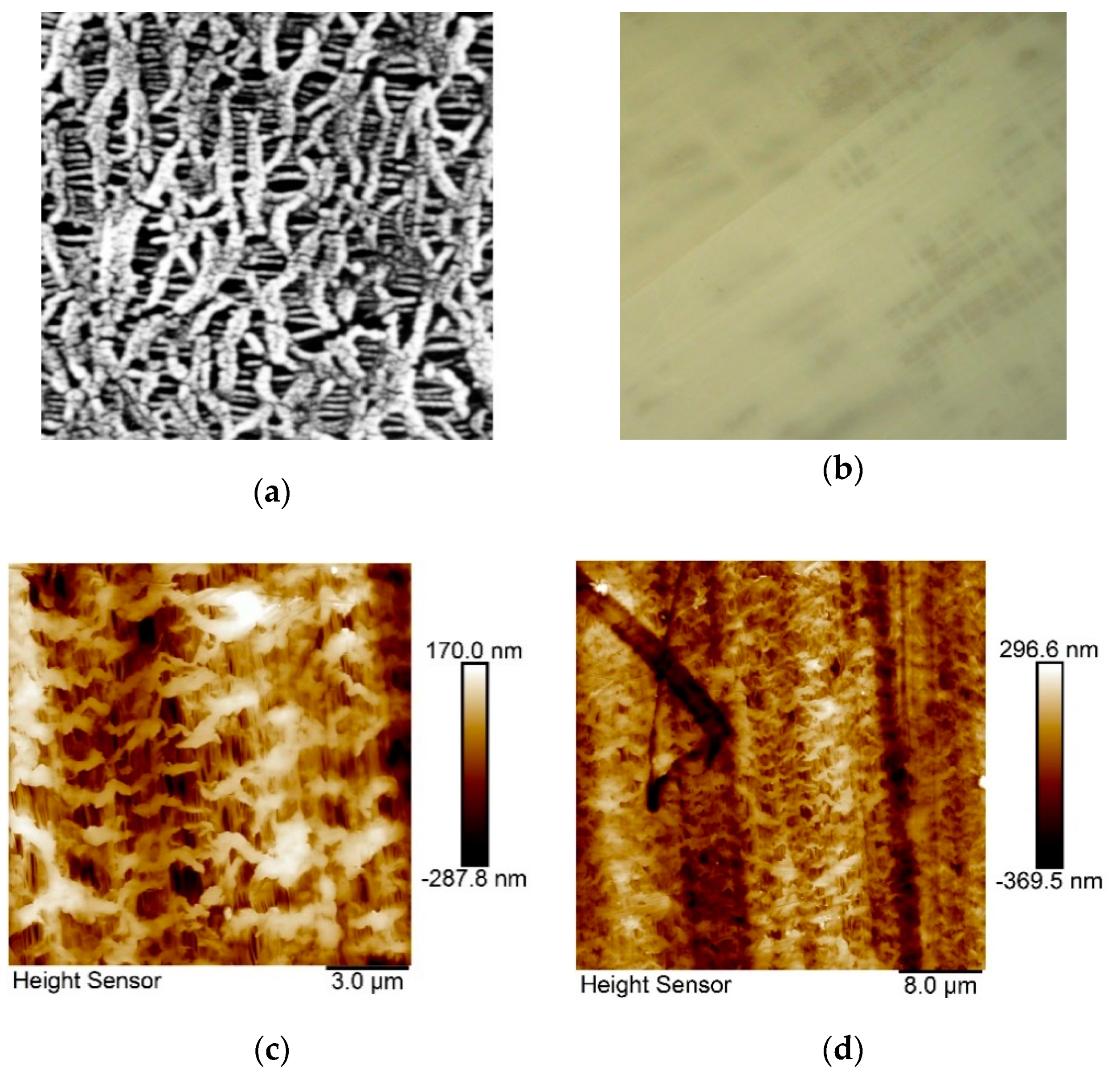


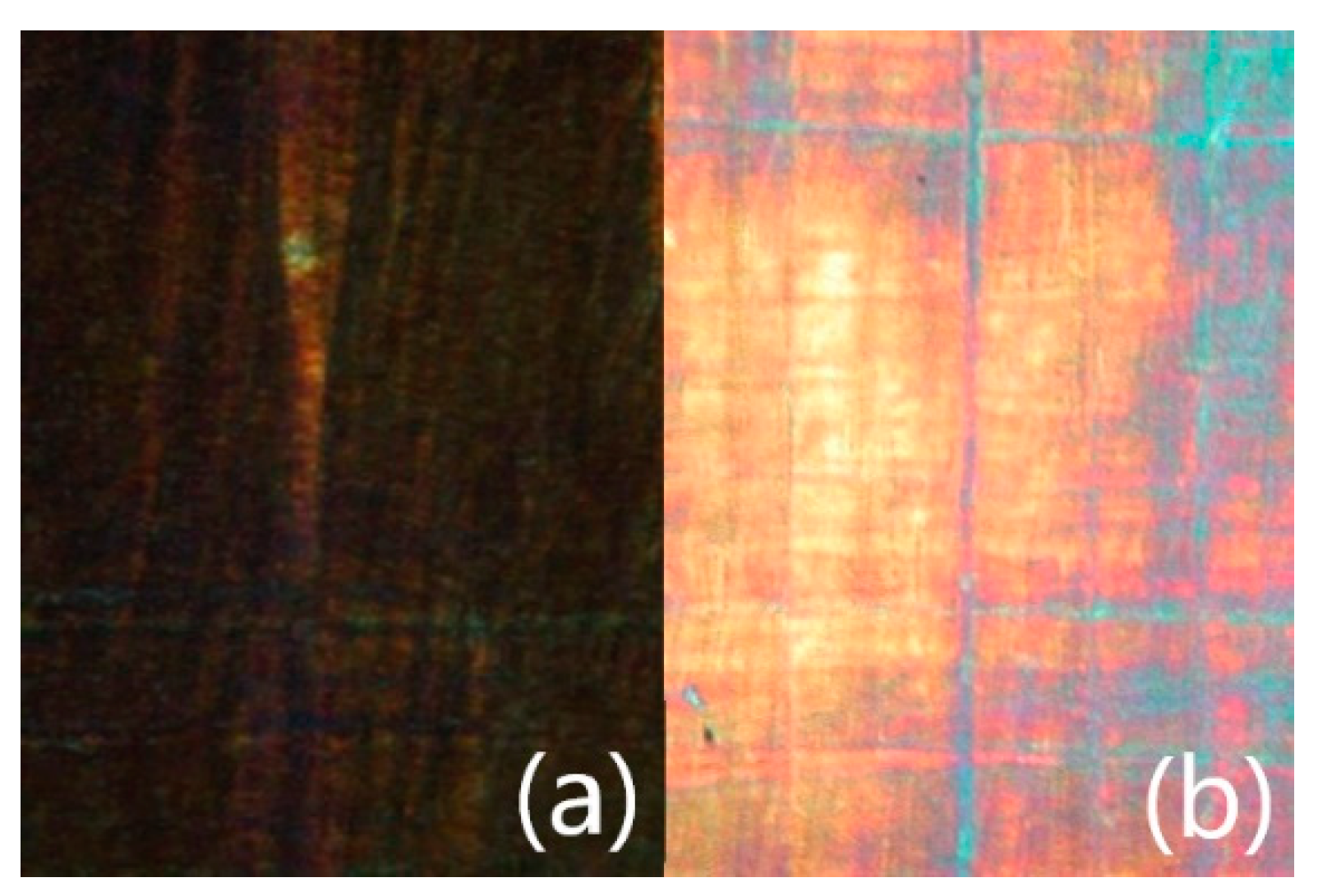
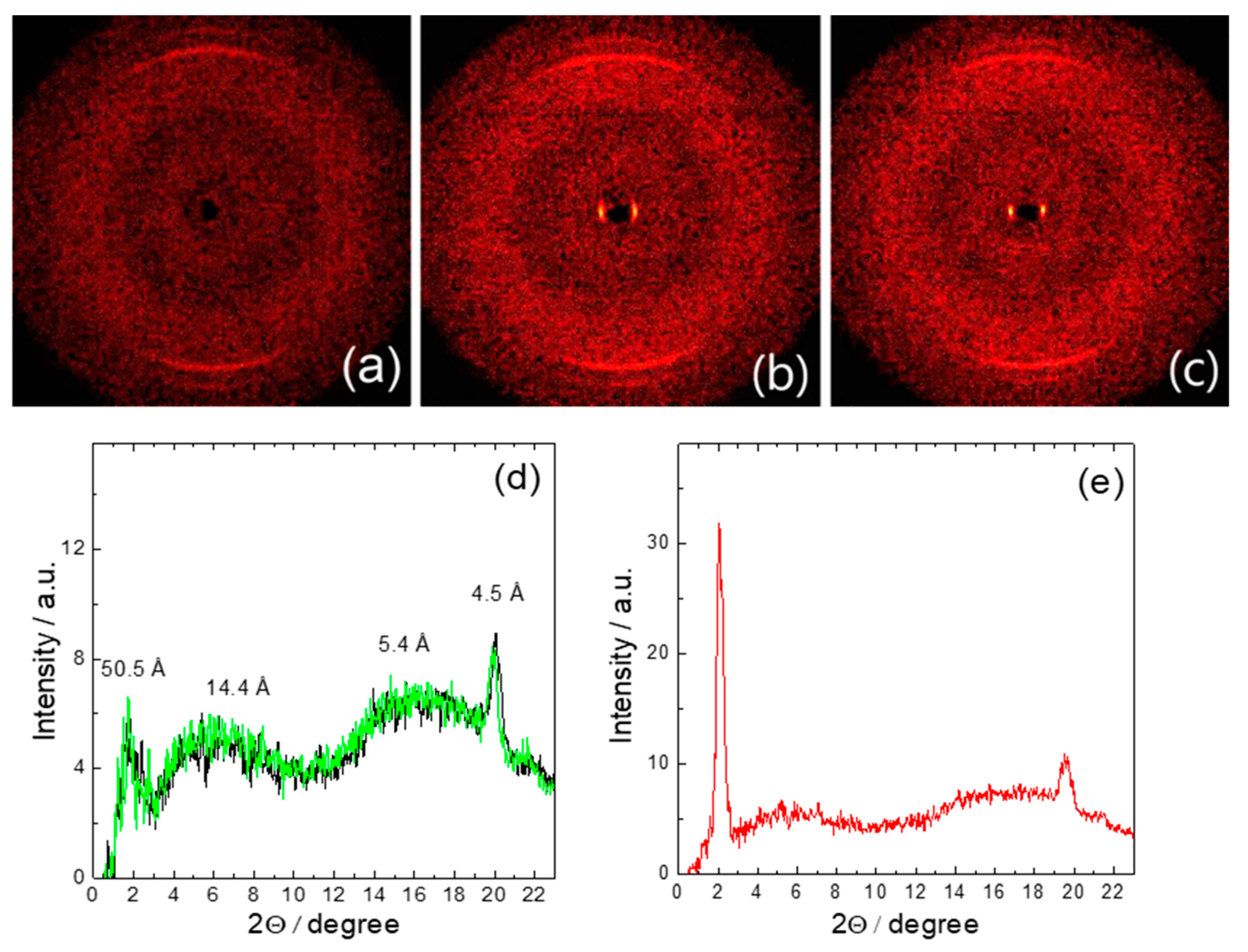
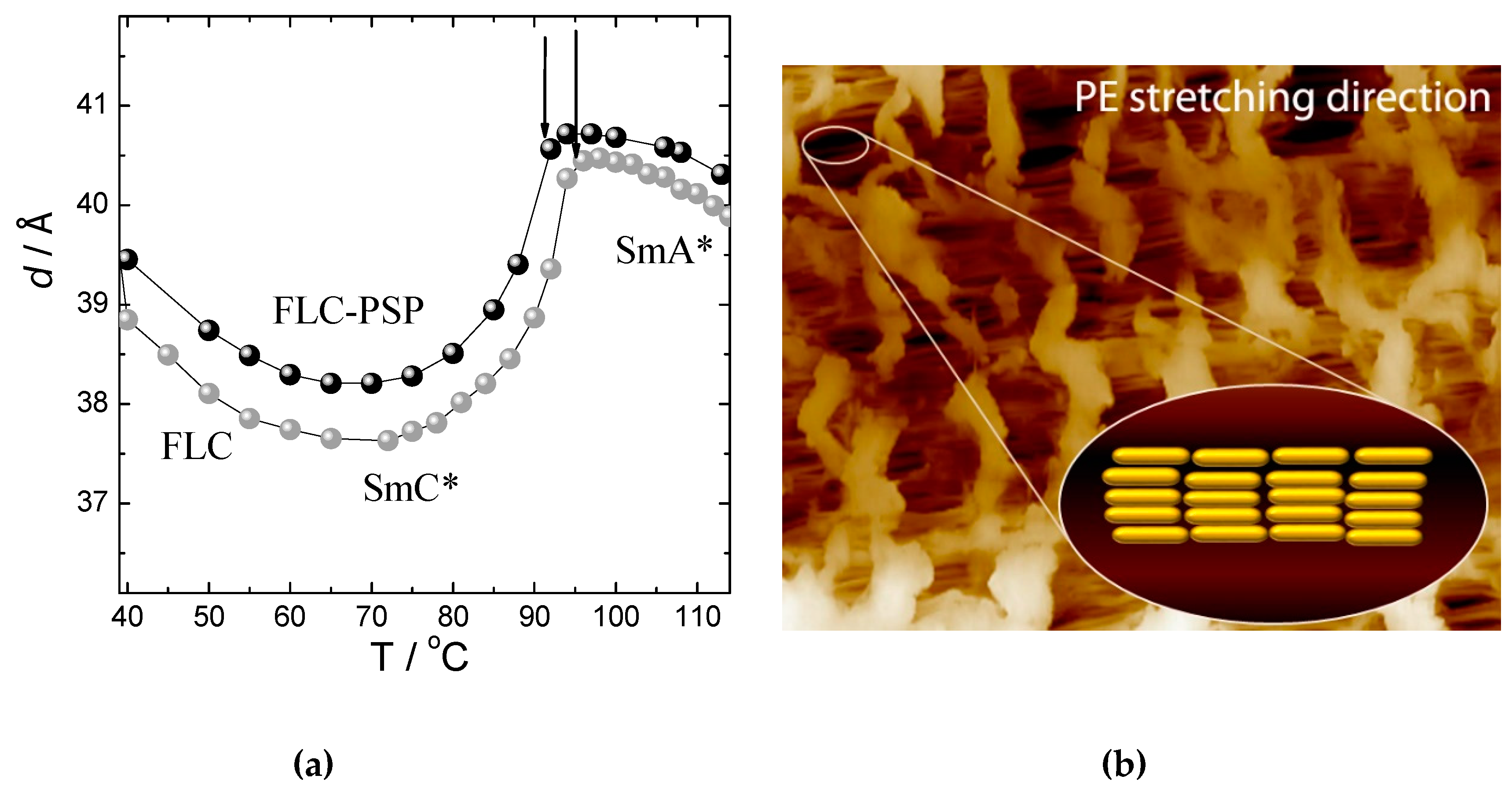

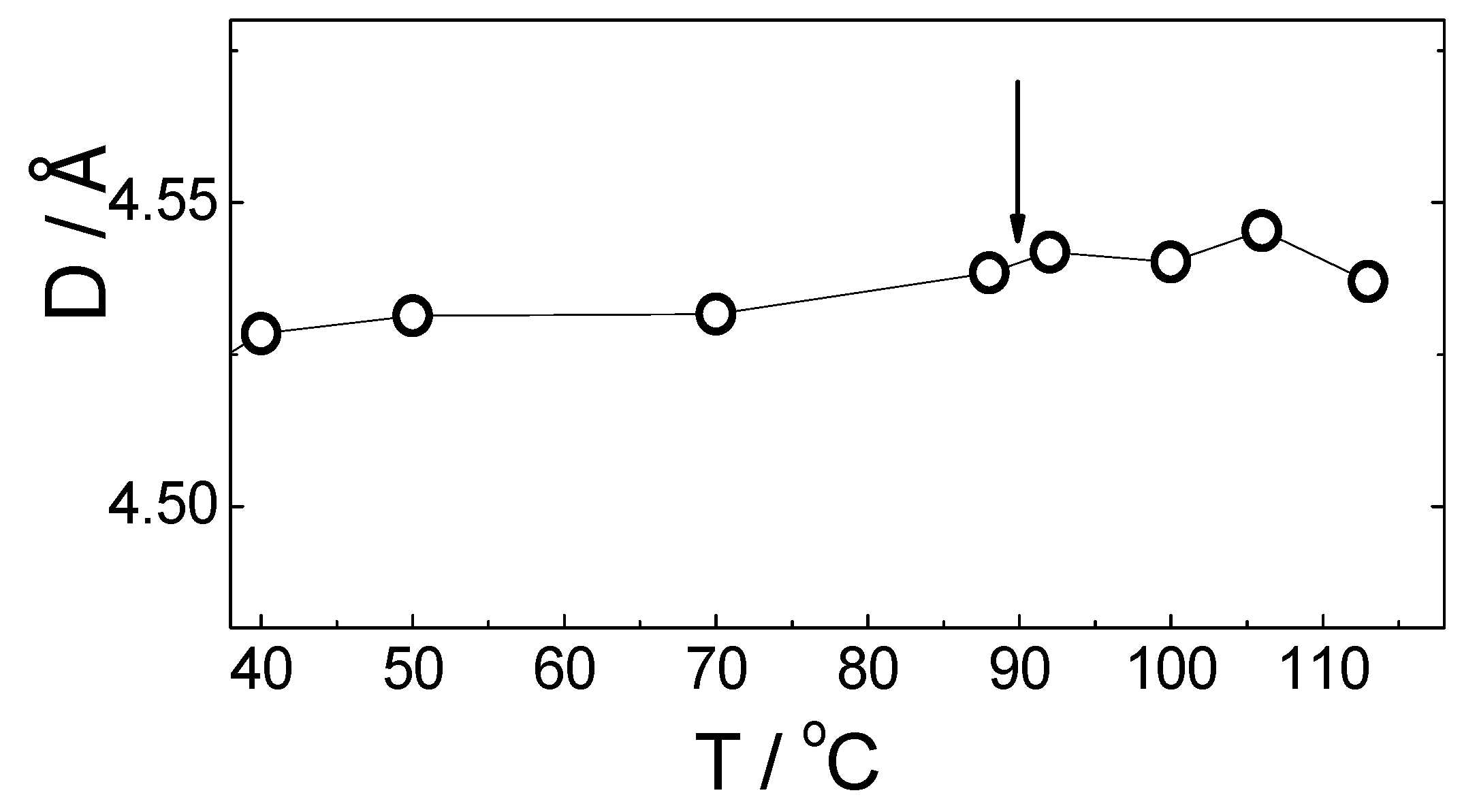
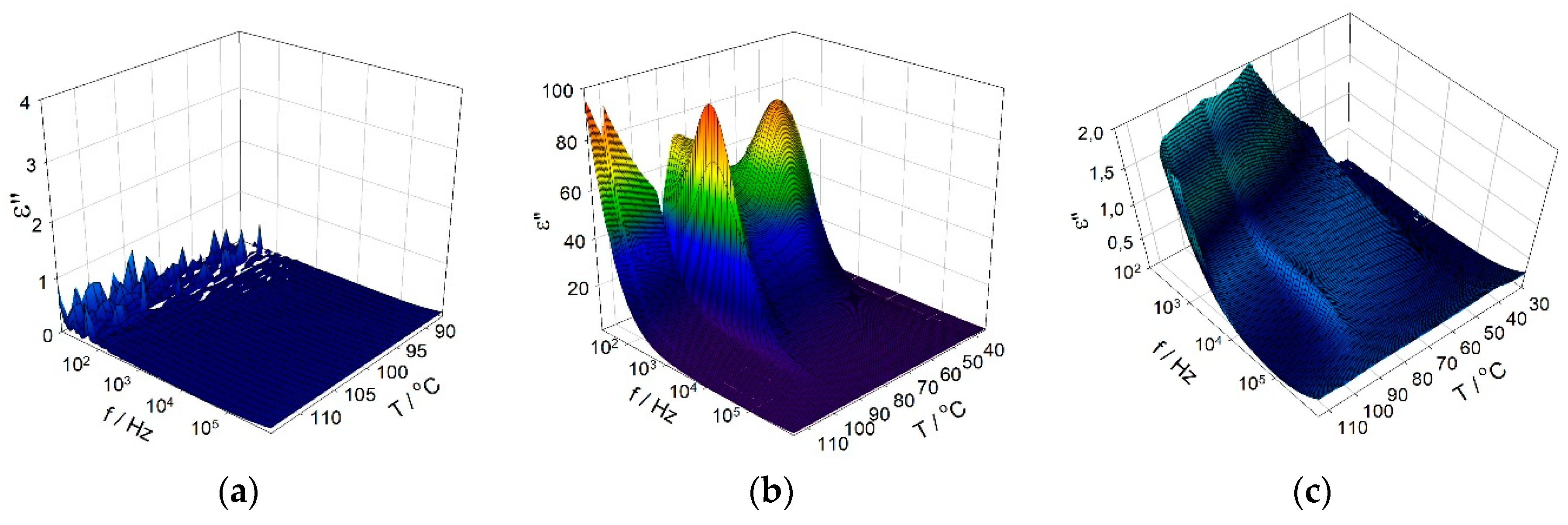
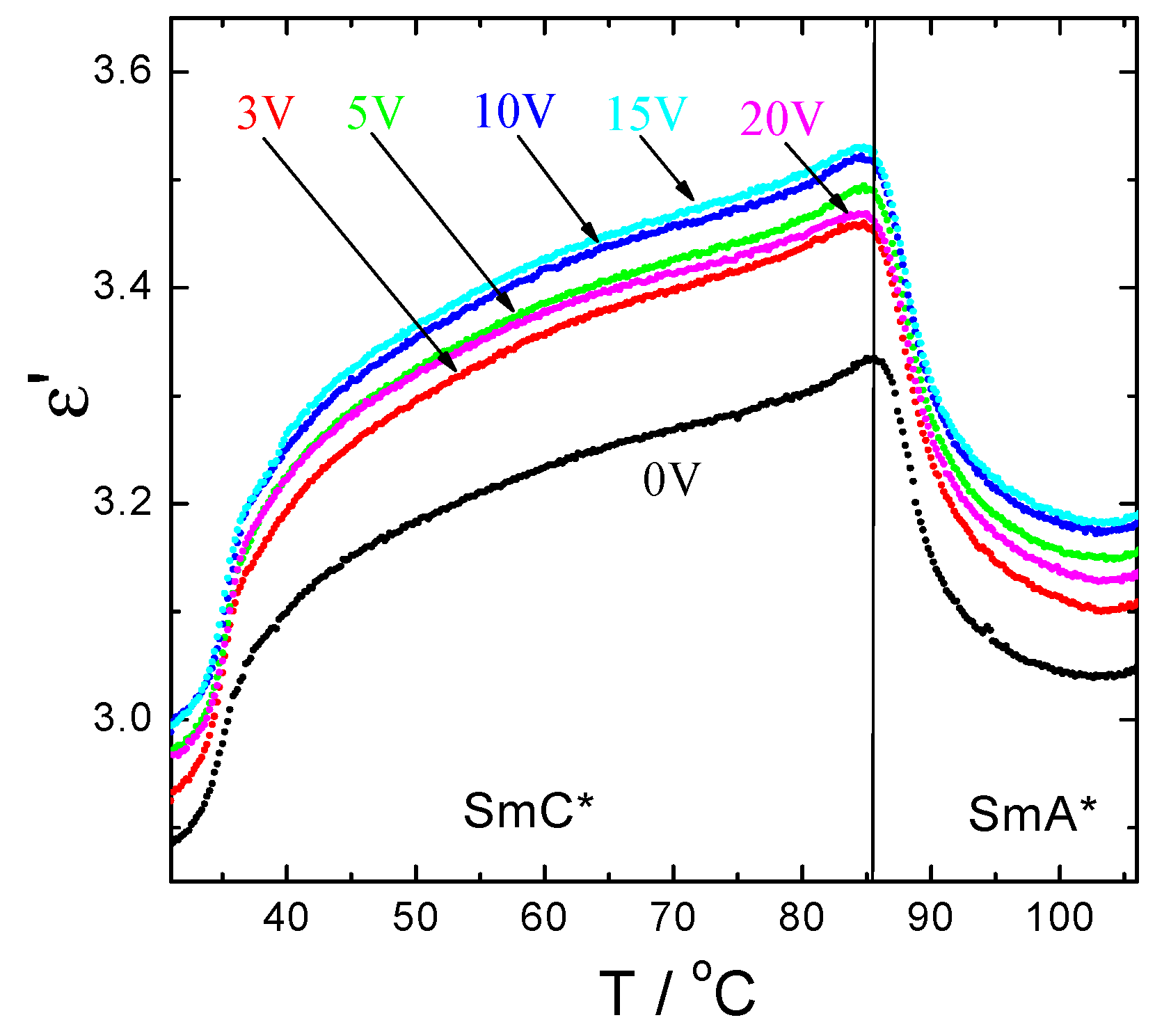
| Material | Cr | °C | Hex* | °C | SmC* | °C | SmA* | °C | Iso |
|---|---|---|---|---|---|---|---|---|---|
| Pure FLC | ● | 39 | ● | 42 | ● | 94 | ● | 113 | ● |
| PE-FLC composite | ● | 39 | ● | 42 | ● | 88 | ● | 105 | ● |
© 2020 by the authors. Licensee MDPI, Basel, Switzerland. This article is an open access article distributed under the terms and conditions of the Creative Commons Attribution (CC BY) license (http://creativecommons.org/licenses/by/4.0/).
Share and Cite
Bubnov, A.; Bobrovsky, A.; Rychetský, I.; Fekete, L.; Hamplová, V. Self-Assembling Behavior of Smart Nanocomposite System: Ferroelectric Liquid Crystal Confined by Stretched Porous Polyethylene Film. Nanomaterials 2020, 10, 1498. https://doi.org/10.3390/nano10081498
Bubnov A, Bobrovsky A, Rychetský I, Fekete L, Hamplová V. Self-Assembling Behavior of Smart Nanocomposite System: Ferroelectric Liquid Crystal Confined by Stretched Porous Polyethylene Film. Nanomaterials. 2020; 10(8):1498. https://doi.org/10.3390/nano10081498
Chicago/Turabian StyleBubnov, Alexej, Alexey Bobrovsky, Ivan Rychetský, Ladislav Fekete, and Věra Hamplová. 2020. "Self-Assembling Behavior of Smart Nanocomposite System: Ferroelectric Liquid Crystal Confined by Stretched Porous Polyethylene Film" Nanomaterials 10, no. 8: 1498. https://doi.org/10.3390/nano10081498
APA StyleBubnov, A., Bobrovsky, A., Rychetský, I., Fekete, L., & Hamplová, V. (2020). Self-Assembling Behavior of Smart Nanocomposite System: Ferroelectric Liquid Crystal Confined by Stretched Porous Polyethylene Film. Nanomaterials, 10(8), 1498. https://doi.org/10.3390/nano10081498








